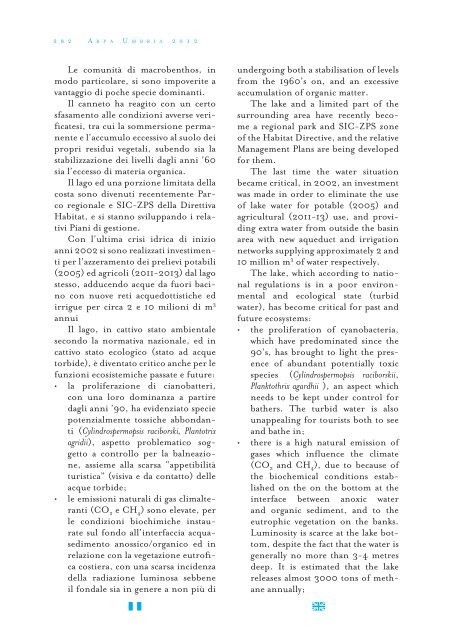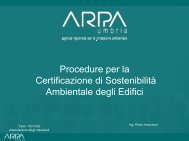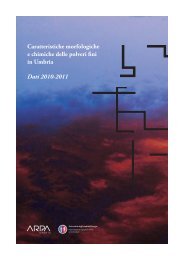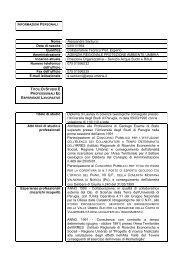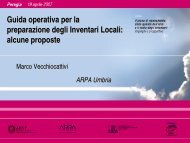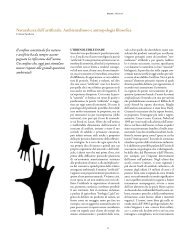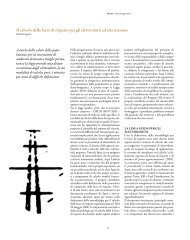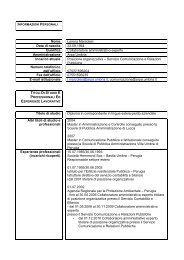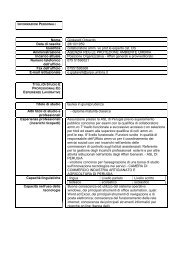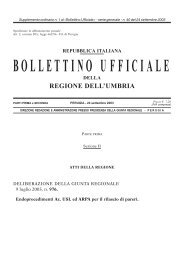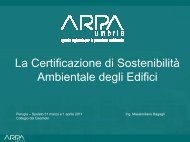Tutela ambientale del Lago Trasimeno - ARPA Umbria
Tutela ambientale del Lago Trasimeno - ARPA Umbria
Tutela ambientale del Lago Trasimeno - ARPA Umbria
Create successful ePaper yourself
Turn your PDF publications into a flip-book with our unique Google optimized e-Paper software.
2 8 2 A r p a U m b r i a 2 0 1 2<br />
Le comunità di macrobenthos, in<br />
modo particolare, si sono impoverite a<br />
vantaggio di poche specie dominanti.<br />
Il canneto ha reagito con un certo<br />
sfasamento alle condizioni avverse verificatesi,<br />
tra cui la sommersione permanente<br />
e l’accumulo eccessivo al suolo dei<br />
propri residui vegetali, subendo sia la<br />
stabilizzazione dei livelli dagli anni ’60<br />
sia l’eccesso di materia organica.<br />
Il lago ed una porzione limitata <strong>del</strong>la<br />
costa sono divenuti recentemente Parco<br />
regionale e SIC-ZPS <strong>del</strong>la Direttiva<br />
Habitat, e si stanno sviluppando i relativi<br />
Piani di gestione.<br />
Con l’ultima crisi idrica di inizio<br />
anni 2002 si sono realizzati investimenti<br />
per l’azzeramento dei prelievi potabili<br />
(2005) ed agricoli (2011-2013) dal lago<br />
stesso, adducendo acque da fuori bacino<br />
con nuove reti acquedottistiche ed<br />
irrigue per circa 2 e 10 milioni di m 3<br />
annui<br />
Il lago, in cattivo stato <strong>ambientale</strong><br />
secondo la normativa nazionale, ed in<br />
cattivo stato ecologico (stato ad acque<br />
torbide), è diventato critico anche per le<br />
funzioni ecosistemiche passate e future:<br />
• la proliferazione di cianobatteri,<br />
con una loro dominanza a partire<br />
dagli anni ’90, ha evidenziato specie<br />
potenzialmente tossiche abbondanti<br />
(Cylindrospermopsis raciborski, Plantotrix<br />
agridii), aspetto problematico soggetto<br />
a controllo per la balneazione,<br />
assieme alla scarsa “appetibilità<br />
turistica” (visiva e da contatto) <strong>del</strong>le<br />
acque torbide;<br />
• le emissioni naturali di gas climalteranti<br />
(CO 2 e CH 4 ) sono elevate, per<br />
le condizioni biochimiche instaurate<br />
sul fondo all’interfaccia acquasedimento<br />
anossico/organico ed in<br />
relazione con la vegetazione eutrofica<br />
costiera, con una scarsa incidenza<br />
<strong>del</strong>la radiazione luminosa sebbene<br />
il fondale sia in genere a non più di<br />
undergoing both a stabilisation of levels<br />
from the 1960’s on, and an excessive<br />
accumulation of organic matter.<br />
The lake and a limited part of the<br />
surrounding area have recently become<br />
a regional park and SIC-ZPS zone<br />
of the Habitat Directive, and the relative<br />
Management Plans are being developed<br />
for them.<br />
The last time the water situation<br />
became critical, in 2002, an investment<br />
was made in order to eliminate the use<br />
of lake water for potable (2005) and<br />
agricultural (2011-13) use, and providing<br />
extra water from outside the basin<br />
area with new aqueduct and irrigation<br />
networks supplying approximately 2 and<br />
10 million m 3 of water respectively.<br />
The lake, which according to national<br />
regulations is in a poor environmental<br />
and ecological state (turbid<br />
water), has become critical for past and<br />
future ecosystems:<br />
• the proliferation of cyanobacteria,<br />
which have predominated since the<br />
90’s, has brought to light the presence<br />
of abundant potentially toxic<br />
species (Cylindrospermopsis raciborskii,<br />
Planktothrix agardhii ), an aspect which<br />
needs to be kept under control for<br />
bathers. The turbid water is also<br />
unappealing for tourists both to see<br />
and bathe in;<br />
• there is a high natural emission of<br />
gases which influence the climate<br />
(CO 2 and CH 4 ), due to because of<br />
the biochemical conditions established<br />
on the on the bottom at the<br />
interface between anoxic water<br />
and organic sediment, and to the<br />
eutrophic vegetation on the banks.<br />
Luminosity is scarce at the lake bottom,<br />
despite the fact that the water is<br />
generally no more than 3-4 metres<br />
deep. It is estimated that the lake<br />
releases almost 3000 tons of methane<br />
annually;


